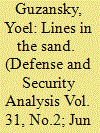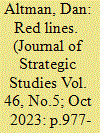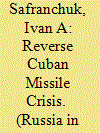| Srl | Item |
| 1 |
ID:
140541


|
|
|
|
|
| Summary/Abstract |
This article explores series of “red lines” issued over the years by the USA and Israel toward Iran and Syria. It argues that the effectiveness of inflexible “red lines” in an environment that is given to rapid change is doubtful. They provide an adversary with the ability to determine when the deterring party will act and when they will not, a situation that is often undesirable. Moreover, their inflexible nature on the one hand opens the doors for circumvention while technically staying within their parameters. On the other hand, a strategy of more ambiguous “red lines” that allow flexibility in choosing the time, intensity, and nature of the response could also achieve a considerable deterrent effect, provided that they do not remain mere bluffs.
|
|
|
|
|
|
|
|
|
|
|
|
|
|
|
|
| 2 |
ID:
193175


|
|
|
|
|
| Summary/Abstract |
Using declassified materials to examine the eleven red lines of the Cuban Missile Crisis, this study qualifies and amends two popular beliefs about them: failing to punish violations damages credibility and deterrence requires declaring unambiguous red lines. I argue, first, that violations of red lines create fleeting ‘windows of credibility’ wherein violators fear retaliation. If declarers move quickly, they can convert non-enforcement into a bargaining chip, exchanging it for concessions while avoiding escalation. Second, rather than wholly embrace clarity or ambiguity, declarers frequently optimize by combining clear demands with ambiguity about the consequences of crossing those lines.
|
|
|
|
|
|
|
|
|
|
|
|
|
|
|
|
| 3 |
ID:
189209


|
|
|
|
|
| Summary/Abstract |
Armen Oganesyan, Editor-in-Chief of International Affairs: Natalia Ivanovna [Koneva], Iwishyou the best on this wonderful holiday - Victory Day! You chair the Victory Commanders Memorial Foundation, which has united the descendants of the great Soviet military leaders. What were relations among the Soviet generals like - for example, between your father and Georgy Zhukov?
|
|
|
|
|
|
|
|
|
|
|
|
|
|
|
|
| 4 |
ID:
189836


|
|
|
|
|
| Summary/Abstract |
This article conceptualizes the current crises around Ukraine and Taiwan
as “a reverse Cuban missile crisis.” The Cuban missile crisis was a turning
point in the history of the Cold War. The two superpowers found themselves
at the brink of mutual annihilation and turned to negotiations to prevent
it. Today the transformation of the world order and escalation of the great
power competition can culminate in a new crisis like the Cuban one, and
with a similar outcome. However, in contrast to the USSR which ultimately
recognized the United States’ red lines, today the U.S. does not recognize
Russia’s and China’s red lines, denying the very legitimacy of red lines as
such. The U.S. plans to retain its hegemony and seeks to achieve it with the
help of its regional allies. This strategy of “offshore balancing” has proven
to be quite useful for the U.S., which seems to ignore any discontent coming
from Russia and China.
|
|
|
|
|
|
|
|
|
|
|
|
|
|
|
|